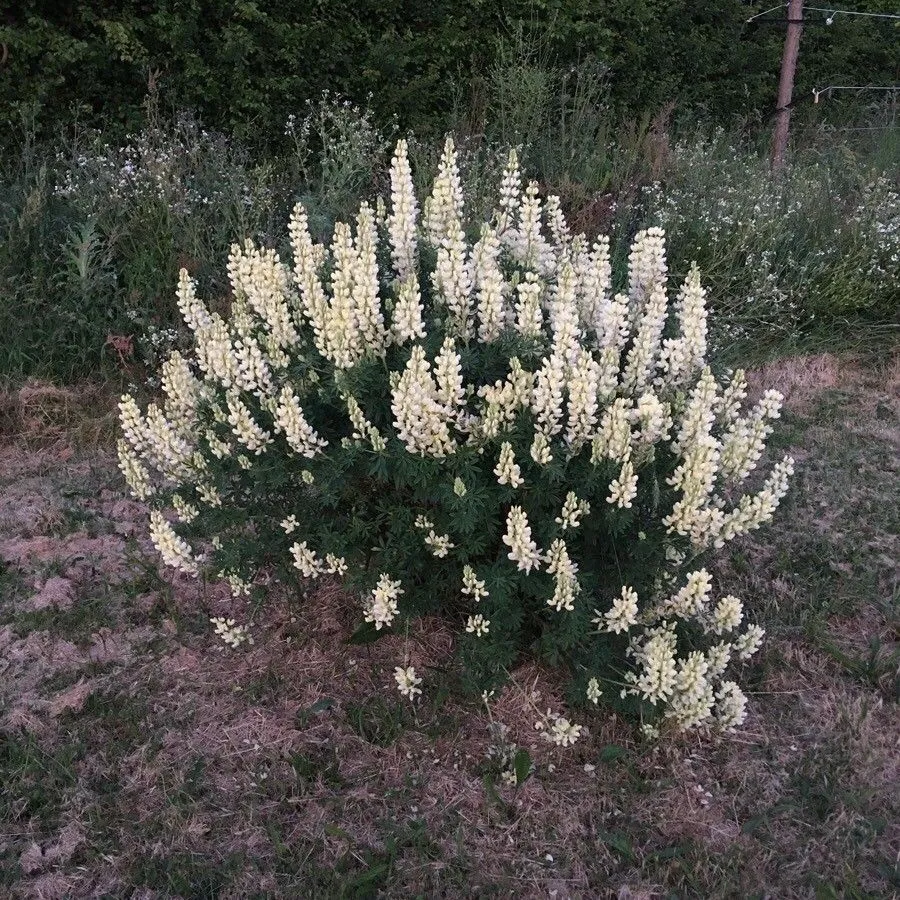
Author: Sims
Bibliography: Bot. Mag. 18: t. 682 (1803)
Year: 1803
Status: accepted
Rank: species
Genus: Lupinus
Vegetable: False
Observations: Washington to California
Bush lupine, scientifically known as Lupinus arboreus, is a captivating plant that belongs to the Fabaceae family. Described meticulously in the early 19th-century botanical literature “Botanical Magazine” by Sims in the year 1803, this perennial plant has established itself as a prominent species in various regions along the West Coast of the United States, stretching from Washington to California.
The striking appearance of bush lupine makes it easily recognizable in the wild. Its elongated clusters, or racemes, of vibrant blossoms come in a spectrum of hues, predominantly featuring shades of yellow and occasionally purple. These beautiful blooms, which persist from early spring to mid-summer, not only add a burst of color to the landscape but also play a crucial role in supporting local wildlife. The flowers are known to attract an array of pollinators, including bees and butterflies, which are essential for ecological balance and the continued proliferation of the species.
Bush lupine is not just decorative; it is also an instrumental part of its ecosystem. This vigorous shrub is adaptable and thrives in well-drained, sandy soils often found in its native coastal habitats. Its extensive root system aids in stabilizing soil, preventing erosion in the often windy and shifting dune ecosystems where it commonly grows. Furthermore, as a member of the Fabaceae family, bush lupine participates in nitrogen fixation – a process where the plant converts atmospheric nitrogen into a form that can be utilized by other plants. This enriches the soil, enhancing fertility and supporting the health of neighboring vegetation.
The adaptability of Lupinus arboreus has allowed it to extend its presence beyond its native range, although this expansion is sometimes met with ecological challenges. In areas outside its indigenous habitats, bush lupine can become invasive, outcompeting local flora and altering habitat dynamics. Proper management and understanding of its growth patterns are essential to mitigate any adverse impacts on foreign ecosystems.
In summary, bush lupine (Lupinus arboreus) is a dynamic and vital component of the coastal plant community from Washington to California. Its radiant flowers, ecological benefits, and role in nitrogen fixation underscore its significance. The botanical details chronicled by Sims in “Botanical Magazine” remain a foundational reference for understanding this remarkable species.
Deu: baum-lupine
Eng: tree lupin, yellow bush lupine, bush lupine, tree lupine, coastal bush lupine
Swe: gul busklupin
Por: tremoço-de-jardim
Fra: lupin en arbre
Cym: coeden bys y blaidd, coeden bysedd y blaidd
En: Bush lupine, Tree lupin, Tree lupine, Yellow bush lupine, Coastal bush lupine, Yellow Bush-lupine
Ar: ترمس شجري
Fr: Lupin en arbre, Lupin
De: Baum-Lupine
Pl: Lupin ‘Gallery Yellow’
Pt: Tremoço-de-jardim
Sv: Gul busklupin
Cy: Coeden bysedd y blaidd, Coeden Bys y Blaidd
Taken Aug 9, 2015 by EOL − Donna Pomeroy (cc-by-nc)
Taken Sep 14, 2020 by Heras Daniel (cc-by-sa)
Taken Mar 15, 2016 by EOL − yejun (cc-by-nc)
Taken Jun 11, 2021 by raoul dune (cc-by-sa)
Taken Jun 20, 2020 by lili coassin (cc-by-sa)
Taken Jul 8, 2020 by Camilo Price (cc-by-sa)
Taken Oct 28, 2019 by lucas hughes (cc-by-sa)
Taken Jan 30, 2020 by Tara Gray (cc-by-sa)
Taken May 25, 2020 by alan grehan (cc-by-sa)
Taken May 8, 2022 by William Coville (cc-by-sa)
Taken Mar 8, 2022 by Zoia Eugenia (cc-by-sa)
Taken Sep 17, 2020 by Delgado Onelia (cc-by-sa)
Taken Jun 20, 2020 by Lucy Thomas (cc-by-sa)
Taken Aug 5, 2017 by Jm Stéphan (cc-by-sa)
Taken May 8, 2022 by William Coville (cc-by-sa)
Taken May 5, 2013 by EOL − Shona Treanor (cc-by-nc)
Taken Nov 26, 2014 by EOL − Jon Sullivan (cc-by-nc)
Taken May 5, 2013 by EOL − Shona Treanor (cc-by-nc)
Taken Feb 24, 1999 by EOL − Beatrice F. Howitt (cc-by-nc-sa)
Taken Sep 14, 2020 by Heras Daniel (cc-by-sa)
Taken Apr 16, 2020 by Khadijah Khan (cc-by-sa)
Taken May 28, 2018 by Véronique Le Mave (cc-by-sa)
Taken Jun 4, 2014 by EOL − Steve Matson (cc-by-nc)
Taken Jun 9, 2011 by EOL − Zoya Akulova (cc-by-nc)
Taken Jul 8, 2018 by Jennifer Soukup (cc-by-sa)
Taken Dec 4, 2019 by Vincent LIFRAN (cc-by-sa)
Taken Jun 17, 2022 by Tim Lower (cc-by-sa)
© copyright of the Board of Trustees of the Royal Botanic Gardens, Kew.
© copyright of the Board of Trustees of the Royal Botanic Gardens, Kew.
© copyright of the Board of Trustees of the Royal Botanic Gardens, Kew.
Growth form: Single Stem
Growth habit: Subshrub, Shrub
Growth rate: Moderate
Ph maximum: 7.5
Ph minimum: 6.0
Light: 8
Atmospheric humidity: 5
Soil nutriments: 6
Family: Myrtaceae Author: (F.Muell.) K.D.Hill & L.A.S.Johnson Bibliography: Telopea 6: 402 (1995) Year: 1995 Status:…
Family: Rubiaceae Author: Pierre ex A.Froehner Bibliography: Notizbl. Bot. Gart. Berlin-Dahlem 1: 237 (1897) Year:…
Family: Sapindaceae Author: Koidz. Bibliography: J. Coll. Sci. Imp. Univ. Tokyo 32(1): 38 (1911) Year:…
Family: Asteraceae Author: A.Gray Bibliography: Pacif. Railr. Rep.: 107 (1857) Year: 1857 Status: accepted Rank:…
Family: Fabaceae Author: Medik. Bibliography: Vorles. Churpfälz. Phys.-Ökon. Ges. 2: 398 (1787) Year: 1787 Status:…
Family: Aspleniaceae Author: (Cav.) Alston Bibliography: Bull. Misc. Inform. Kew 1932: 309 (1932) Year: 1932…